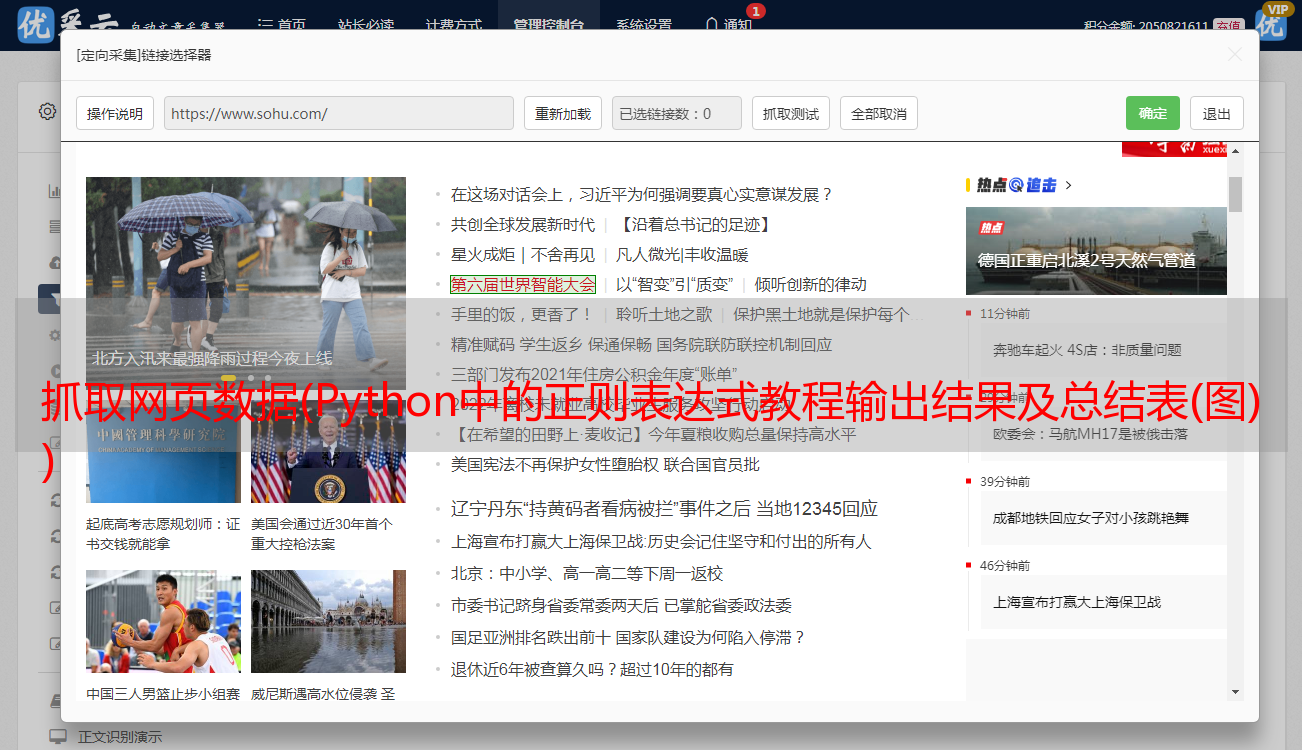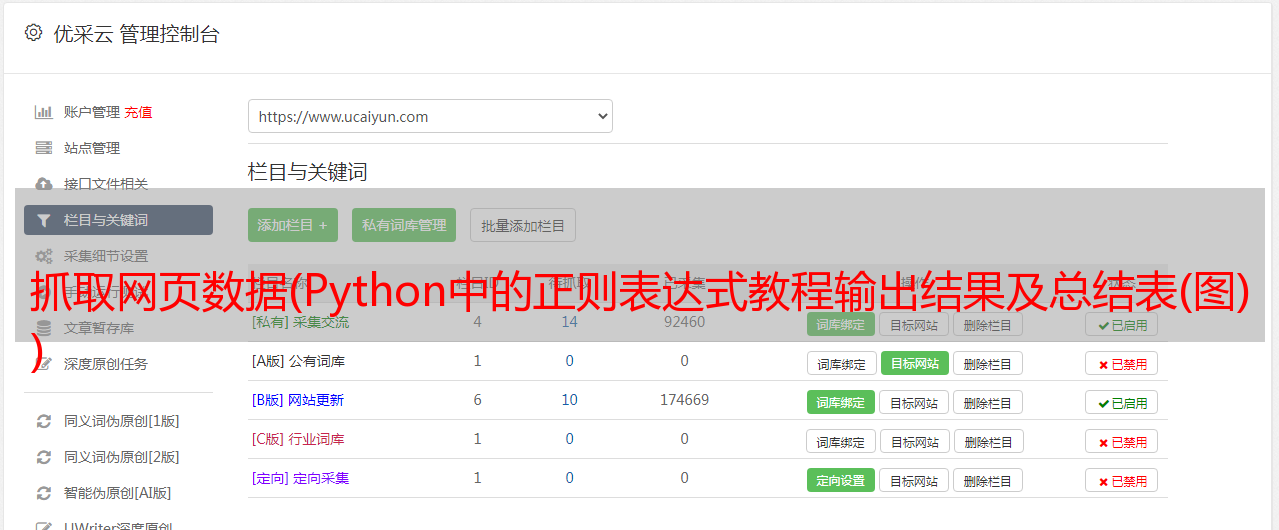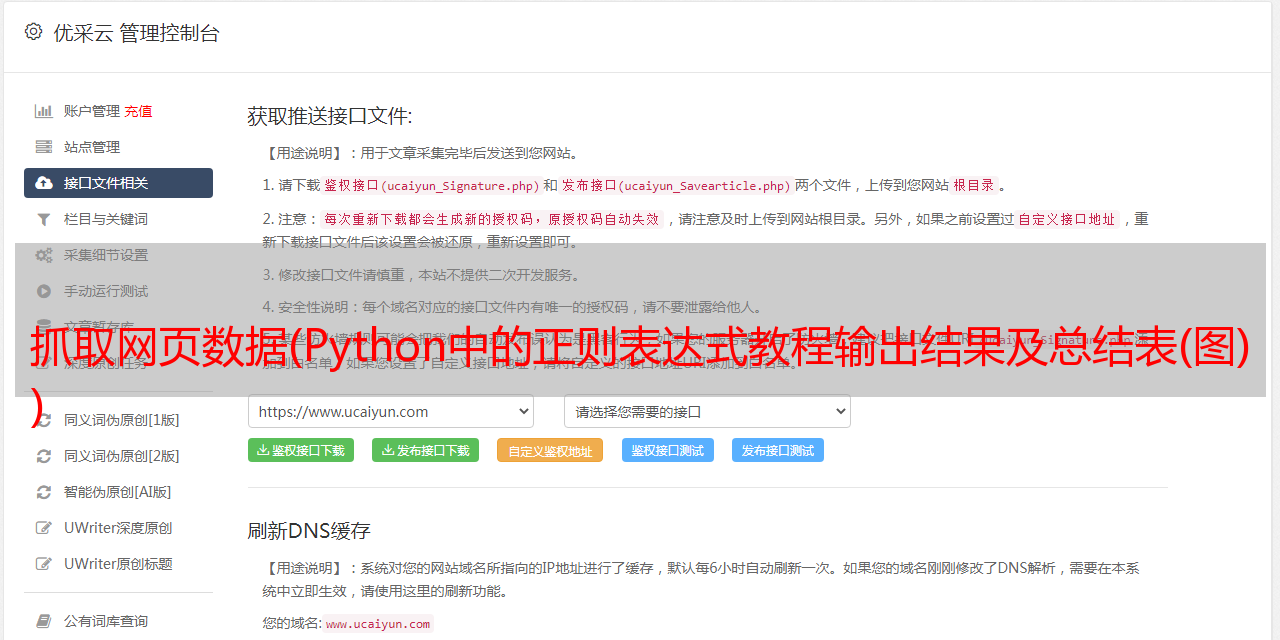抓取网页数据(Python中的正则表达式教程输出结果及总结表(图) )
优采云 发布时间: 2022-02-25 13:01抓取网页数据(Python中的正则表达式教程输出结果及总结表(图)
)
摘要:这篇文章是关于使用Python爬取网页数据的三种方法;它们是正则表达式(re)、BeautifulSoup 模块和 lxml 模块。本文所有代码均在python3.5中运行。
本文截取【中央气象台】首页头条信息():
它的 HTML 层次结构是:
抓取href、title和tags的内容。
一、正则表达式
复制外层HTML:
高温警告
代码:
# coding=utf-8
import re, urllib.request
url = 'http://www.nmc.cn'
html = urllib.request.urlopen(url).read()
html = html.decode('utf-8') #python3版本中需要加入
links = re.findall('<a target="_blank" href="(.+?)" title',html)
titles = re.findall('a target="_blank" .+? title="(.+?)"',html)
tags = re.findall('a target="_blank" .+? title=.+?(.+?)/a',html)
for link,title,tag in zip(links,titles,tags):
print(tag,url+link,title)
/pre/p
p正则表达式符号 '.' 表示匹配任何字符串(\n 除外);'+' 表示匹配前面正则表达式的零次或多次出现;'?' 表示匹配 0 或 1 前面的正则表达式。更多信息请参考Python中的正则表达式教程/p
p输出如下:/p
p高温预警 中央气象台7月13日18:00继续发布高温橙色预警/p
p山洪灾害气象预警 水利部、中国气象局于7月13日18:00联合发布山洪灾害气象预警/p
p强对流天气预警 中央气象台于7月13日18:00继续发布强对流天气蓝色预警/p
p地质灾害气象风险预警 国土资源部、中国气象局于7月13日18:00联合发布地质灾害气象风险预警/p
p二、BeautifulSoup 模块/p
pBeautiful Soup 是一个非常流行的 Python 模块。该模块可以解析网页并提供方便的界面来定位内容。/p
p复制选择器:/p
p#alarmtip > ul > li.waring > a:nth-child(1)/p
p因为这里我们抓取的是多个数据,而不仅仅是第一个,所以我们需要把它改成:/p
p#alarmtip > ul > li.waring > a/p
p代码:/p
ppre class="brush:python;gutter:true;"from bs4 import BeautifulSoup
import urllib.request
url = 'http://www.nmc.cn'
html = urllib.request.urlopen(url).read()
soup = BeautifulSoup(html,'lxml')
content = soup.select('#alarmtip > ul > li.waring > a')
for n in content:
link = n.get('href')
title = n.get('title')
tag = n.text
print(tag, url + link, title)
输出与上面相同。
三、lxml 模块
Lxml 是基于 XML 解析库 libxml2 的 Python 包装器。这个模块是用C语言编写的,解析速度比Beautiful Soup快,但是安装过程比较复杂。
代码:
import urllib.request,lxml.html
url = 'http://www.nmc.cn'
html = urllib.request.urlopen(url).read()
tree = lxml.html.fromstring(html)
content = tree.cssselect('li.waring > a')
for n in content:
link = n.get('href')
title = n.get('title')
tag = n.text
print(tag, url + link, title)
输出与上面相同。
四、将抓取的数据存储在列表或字典中
以 BeautifulSoup 模块为例:
from bs4 import BeautifulSoup
import urllib.request
url = 'http://www.nmc.cn'
html = urllib.request.urlopen(url).read()
soup = BeautifulSoup(html,'lxml')
content = soup.select('#alarmtip > ul > li.waring > a')
######### 添加到列表中
link = []
title = []
tag = []
for n in content:
link.append(url+n.get('href'))
title.append(n.get('title'))
tag.append(n.text)
######## 添加到字典中
for n in content:
data = {
'tag' : n.text,
'link' : url+n.get('href'),
'title' : n.get('title')
}
五、总结
表 2.1 总结了每种抓取方法的优缺点。





